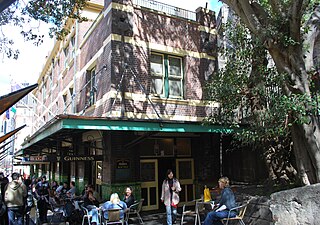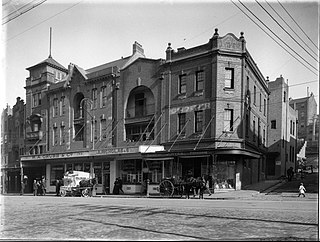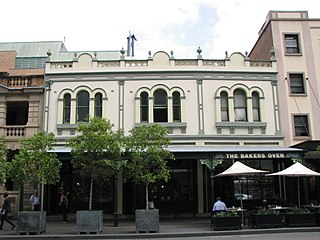
The Strand Arcade is a heritage-listed Victorian-style retail arcade located at 195–197 Pitt Street in the heart of the Sydney central business district, between Pitt Street Mall and George Street in the City of Sydney local government area of New South Wales, Australia. It was designed by John B. Spencer, assisted by Charles E. Fairfax; and built from 1890 to 1892 by Bignell and Clark (1891), with renovations completed by Stephenson & Turner (1976). The only remaining arcade of its kind in Sydney, the property was added to the New South Wales State Heritage Register on 13 December 2011.

The Mercantile Hotel is a heritage-listed pub located at 25–27 George Street, in the inner city Sydney suburb of The Rocks in the City of Sydney local government area of New South Wales, Australia. It was designed by Spain & Cosh Architects and built in 1914. The property is owned by Place Management NSW, an agency of the Government of New South Wales. It was added to the New South Wales State Heritage Register on 10 May 2002.

Samson's Cottage is a historic building in Sydney, Australia. It was built for William Cormack and built from 1883, and over the years, it has housed a Chinese laundry, an art gallery and an antique shop. It is located at 75–75.5 George Street in the inner city suburb of The Rocks in the City of Sydney local government area. The property is owned by Property NSW, an agency of the Government of New South Wales. It was added to the New South Wales State Heritage Register on 10 May 2002.

The Union Bond Store is a heritage-listed former warehouse, bond store and Westpac bank branch and museum located at 47 George Street in the inner city Sydney suburb of The Rocks in the City of Sydney local government area of New South Wales, Australia. It was designed by John Bibb and built from 1841 to 1842. It is also known as Union Bond Store (former) and Westpac Bank. The property is owned by Property NSW, an agency of the Government of New South Wales. It was added to the New South Wales State Heritage Register on 10 May 2002.

139–141 George Street are heritage-listed former terrace houses and now shops located at 139–141 George Street in the inner city Sydney suburb of The Rocks in the City of Sydney local government area of New South Wales, Australia. It was built from 1881 to 1882. It is also known as three storey stone building. The property is owned by Property NSW, an agency of the Government of New South Wales. It was added to the New South Wales State Heritage Register on 10 May 2002.

95-99 George Street, The Rocks are heritage-listed shops and cafe and former dwellings located at 95-99 George Street in the inner city Sydney suburb of The Rocks in the City of Sydney local government area of New South Wales, Australia. It was built from 1868 to 1868. The property is owned by Property NSW, an agency of the Government of New South Wales. It was added to the New South Wales State Heritage Register on 10 May 2002.

107–109 George Street, The Rocks is a heritage-listed restaurant and former retail building, residence and bakery located at 107–109 George Street, in the inner city suburb of The Rocks in the City of Sydney local government area of New South Wales, Australia. It was built during 1860. It is also known as Rockpool Restaurant (former); and William Blue Dining. The property is owned by Property NSW, an agency of the Government of New South Wales. It was added to the New South Wales State Heritage Register on 10 May 2002.

149–151 George Street, The Rocks is a heritage-listed duty-free store complex and former retail building and residence located at 149–151 George Street, in the inner city Sydney suburb of The Rocks in the City of Sydney local government area of New South Wales, Australia. It was built from 1913 to 1913. It is also known as part of the Duty Free Store complex. The property is owned by Property NSW, an agency of the Government of New South Wales. It was added to the New South Wales State Heritage Register on 10 May 2002.

145 George Street, The Rocks is a heritage-listed duty-free store complex and former retail building and residence located at 145 George Street, in the inner city Sydney suburb of The Rocks in the City of Sydney local government area of New South Wales, Australia. It was built in 1892. It is also known as Currently part of Duty Free Store complex. The property is owned by Property NSW, an agency of the Government of New South Wales. It was added to the New South Wales State Heritage Register on 10 May 2002.

103 George Street, The Rocks is a heritage-listed retail building and residence located 103 George Street in the inner city Sydney suburb of The Rocks in the City of Sydney local government area of New South Wales, Australia. It was built during 1856. It is also known as Joe Bananas (current) and Ariel Bookshop (former). The property is owned by Property NSW, an agency of the Government of New South Wales. It was added to the New South Wales State Heritage Register on 10 May 2002.

123–125 George Street, The Rocks are heritage-listed shops and former residences located in the inner Sydney suburb of The Rocks in New South Wales, Australia. It was built for Thomas Playfair during 1882. The property is owned by Property NSW, an agency of the Government of New South Wales. It was added to the New South Wales State Heritage Register on 10 May 2002.

The Sydney Water Head Office, now known as Kimpton Margot Sydney is a heritage-listed hotel, formerly an office building, located in the Sydney central business district in New South Wales, Australia. It was designed by Henry Budden & Mackey and built from 1938 to 1939 by Howie Moffat & Co, commonly called the Water Board Building and formally the Metropolitan Water, Sewerage and Drainage Board Headquarters. Following Sydney Water's relocation to Parramatta in 2009, it was converted into a hotel (as The Primus Hotel, part of a chain of hotels owned by the municipal government of Shanghai, while the adjoining 1969 office building was redeveloped to become the Greenland Centre. In 2021, Primus Hotel Sydney closed, and in 2022 the hotel re-opened as part of the Kimpton chain operated by IHG Hotels & Resorts.

The Public Trust Office is a heritage-listed office building at 19–21 O'Connell Street, Sydney, Australia. It was designed by Ross & Rowe and built from 1926. It is also known as the Public Trustee. It was originally known as Rofe Chambers. It was added to the New South Wales State Heritage Register on 2 April 1999.

New South Wales Club building is a heritage-listed former clubhouse and now offices located at 31 Bligh Street, in the Sydney central business district, in the City of Sydney local government area of New South Wales, Australia. It was designed by William Wardell and built from 1886 to 1887 by John Try. It housed the New South Wales Club from 1886 until the club's amalgamation with the Australian Club in 1969. It was then sold and the two rear wings demolished in 1973 before the surviving front portion was converted to offices. It was added to the New South Wales State Heritage Register on 2 April 1999.

107–109 Bathurst Street, Sydney is a heritage-listed former bank building and now KFC fast food restaurant located at 107–109 Bathurst Street, Sydney, New South Wales, Australia. The property is privately owned. It was added to the New South Wales State Heritage Register on 2 April 1999.

341 George Street, Sydney is a heritage-listed bank building located at 341 George Street, in the Sydney central business district, in the City of Sydney local government area of New South Wales, Australia. It was built from 1927 to 1932 and housed the headquarters of the Bank of New South Wales, and later Westpac. It is also known as Westpac Bank building and Bank of NSW building. Westpac sold the building in 2002, but continues to lease the lower floors for use as banking chambers. The upper floors are leased by other tenants.

The City Mutual Life Assurance Building is a heritage-listed commercial building located at 60-66 Hunter Street, in the Sydney central business district, New South Wales, Australia. It was built during 1936. It is also known as CML Building and 10 Bligh Street. It was added to the New South Wales State Heritage Register on 2 April 1999.

Grahame's Corner is a heritage-listed commercial and office building located at 142-144 Pitt Street, in the Sydney central business district, in the City of Sydney local government area of New South Wales, Australia. It was designed by G. A. Morell and built from 1877 to 1882. It is also known as Grahams Corner and the AMFIS Building. The property was added to the New South Wales State Heritage Register on 2 April 1999.

The Trust Building is a heritage-listed office and commercial building and former hotel located at 72-72a Castlereagh Street, in the Sydney central business district, in the City of Sydney local government area of New South Wales, Australia. It was designed by firm Robertson & Marks and built from 1914 to 1916 by Stuart Brothers. It was added to the New South Wales State Heritage Register on 2 April 1999.

The Bulletin Place Warehouses are a series of three heritage-listed former warehouses and now souvenir sales office, commercial offices, health club, storage area, and restaurant located between 6–18 Bulletin Place, in the Sydney central business district in New South Wales, Australia. The warehouses were built from 1880 and have variously been known as the San Francisco Restaurant. The property is privately owned. It was added to the New South Wales State Heritage Register on 2 April 1999.






















